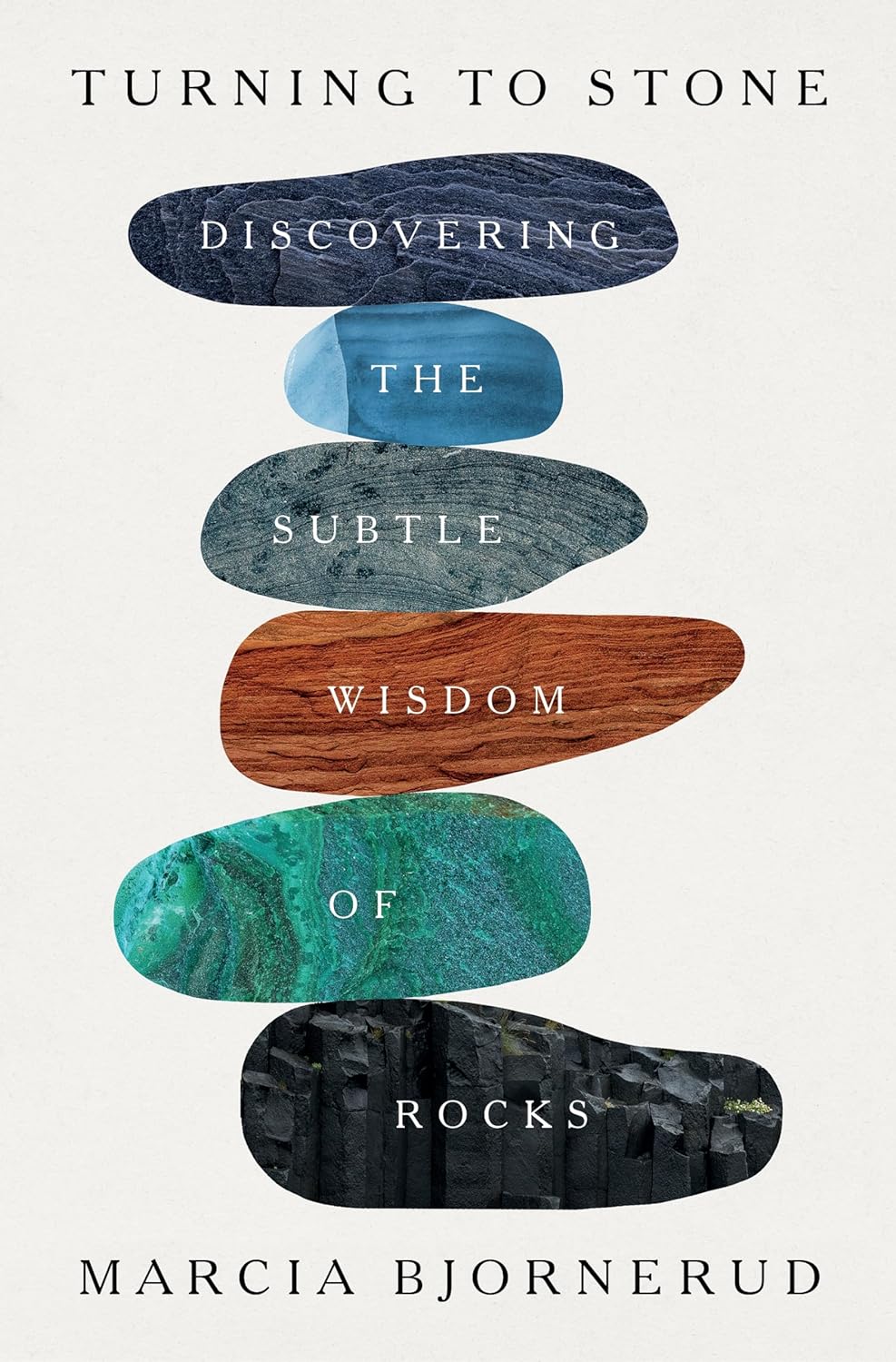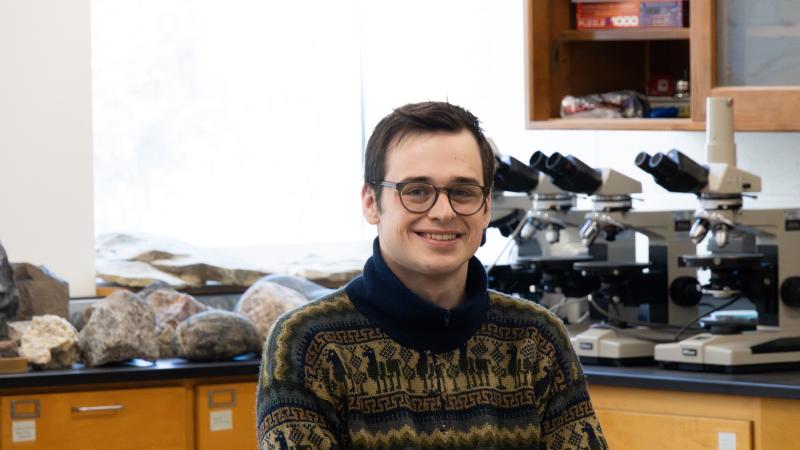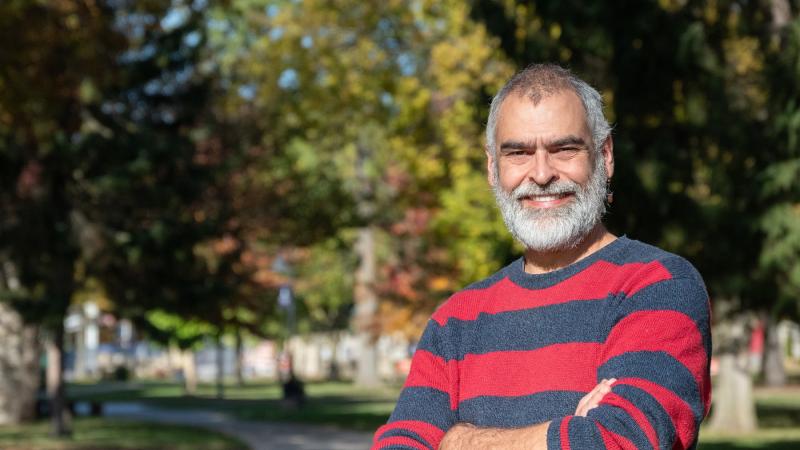Geosciences professor Marcia Bjornerud, one of Lawrence University’s most prolific authors and scholars—a student, teacher, and storyteller of Earth’s past, present, and future—has added a new point of interest in her just-released book.
Herself.
In Turning to Stone: Discovering the Subtle Wisdom of Rocks, released in August by Flatiron Books, Bjornerud weaves her personal footprint into the exploration of Earth’s geologic history, channeling a desire for her fellow earthlings to join her in better understanding where we’ve been and where we’re going. It is her fourth book, following Reading the Rocks in 2005, Timefulness: How Thinking Like a Geologist Can Help Save the World in 2018, and Geopedia in 2022, all critically lauded.
The memoir approach for Turning to Stone is one Bjornerud, the Walter Schober Professor of Environmental Studies and professor of geosciences, was not immediately comfortable with. Following the release of Timefulness, an editor she had not worked with before reached out to suggest she write a memoir about her life as a geologist.
“At first I recoiled from the idea because I’m a private person by nature, and also because my purpose in writing books for popular audiences is not for readers to get to know me but to share with them essential ideas about how their planet works,” Bjornerud said.

In the end, she found value in telling her story, from growing up in western Wisconsin, to her trials and tribulations in becoming a geology scholar, to how her drive to learn and share all she can about our planet infused all aspects of her life, including parenthood, friendships, and her research and teaching since joining the Lawrence faculty in 1995.
“In my earlier books, I had incorporated short personal anecdotes as entry points into geologic concepts, but nothing really autobiographical,” she said. “I finally realized that I could use the arc of my own life—specifically, my deepening understanding of the earth over my career—as a way to ease people into a geologic worldview. With this book, I'm trusting readers to stick with me through some scientific concepts that are more subtle than those I've talked about in my previous books. People may not realize it, but we are currently in a golden age for the geosciences, in which we finally have the conceptual frameworks, instrumentation, and computational capacity to grapple with the immense complexity of the Earth system in four dimensions, including time.”
The book drew a glowing review from The New Yorker, featured online and in the Sept. 2 edition of its print magazine.
“In its pages, what Bjornerud has learned serves to illuminate what she already knew: each of the book’s ten chapters is structured around a variety of rock that provides the context for a particular era of her life, from childhood to the present day,” the review reads. “The result is one of the more unusual memoirs of recent memory, combining personal history with a detailed account of the building blocks of the planet. What the two halves of this tale share is an interest in the evolution of existence—in the forces, both quotidian and cosmic, that shape us.”
In the book’s prologue, Bjornerud speaks to her relationship with geology that has grown from her time as an undergraduate at the University of Minnesota and a graduate student at the University of Wisconsin-Madison. She calls the book an invitation into her “geo-centric” worldview, in which we have much to learn from the rocks.
“If my initial relationship with geology was purely intellectual, it has become over time a philosophical and even spiritual worldview, imbuing my life with meaning,” she writes. “My work as a field geologist has led to unlikely connections with people from across the world—friendships rooted in a shared sense of humility and wonder in the presence of nature. I also have a feeling of amity with rocks, after spending such a large fraction of my waking hours with them over many years, immersed in their narratives.”
"I finally realized that I could use the arc of my own life—specifically, my deepening understanding of the earth over my career—as a way to ease people into a geologic worldview."
Marcia Bjornerud
In addition to her four books, Bjornerud’s storytelling has been showcased frequently in the pages of The New Yorker, Wall Street Journal, and other publications.
When Timefulness was released six years ago, it drew notable honors. It was named to the 2019 Phi Beta Kappa Book Awards Short List; selected as a finalist in the Science and Technology category for the 2018 Los Angeles Times Book Prize; given a PROSE Award from the American Association of Publishers in the category of popular science and mathematics; and long-listed for the PEN America Awards, among the nation’s most prestigious literary awards.
Learn more about Marcia Bjornerud in our On Main Hall Green With ... series of faculty profiles.
Get to know Earth's past, present, and future with the multidisciplinary study of geosciences.
In addition to The New Yorker review, Turning to Stone has already drawn praise from other outlets. Publisher’s Weekly calls it a “remarkably human take on the geological world.” Science News calls it “part memoir, part geology explainer, part meditation on science and society.”
“Bjornerud’s life scaffolds each chapter; the rocks set the scene,” the Science News review reads. “The book is largely chronological, from Bjornerud’s childhood to the present day. Each chapter features a titular rock type that holds some significance to her life.”
Bjornerud hopes blending her “small human story” with those of the rocks will allow readers to see themselves as being part of Earth’s ecosystem.
“The absence of rigorous geoscience classes in schools means that most people spend their entire lives on Earth like bad tourists, enjoying the planet's hospitality without ever learning much about its language and history,” she said. “While not everyone can or should become a geologist, I believe that geologic habits of mind—an instinct for Earth’s rhythms, a feeling for our place in its story—are essential to the physical and psychic well-being of humankind.”




